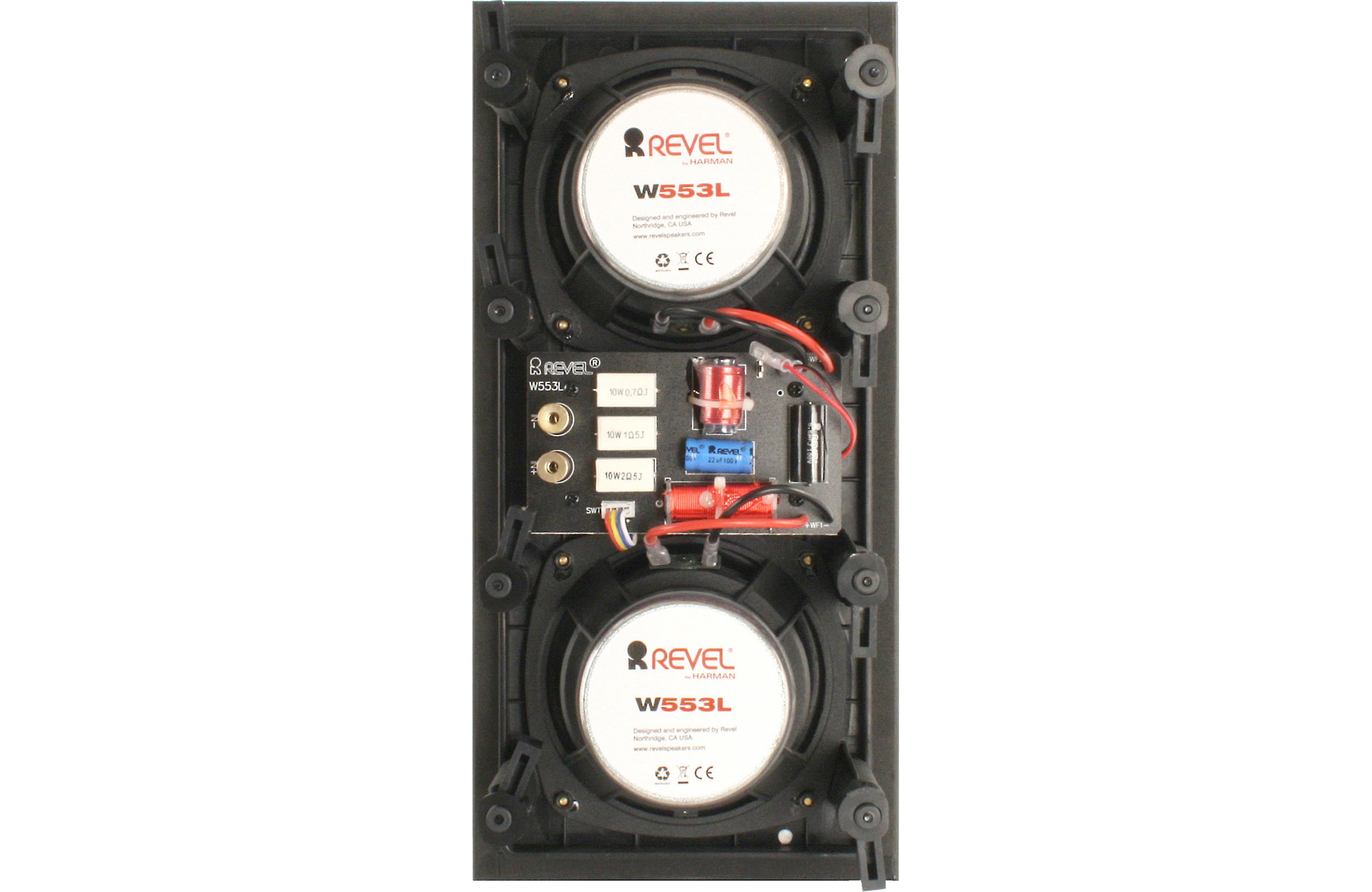This is a detailed measurements of Revel W553L in-wall speaker. It is on kind loan from a member and costs US $495 (each). You can see it on the measurement stand:

As an aside, this speaker was used in double blind test by the owner.
NOTE: our company, Madrona Digital, is a dealer for Harman and hence Revel line. While we don't do any retail business, I thought I let you know about that. Of course the measurements are not subject to bias that way but you are welcome to read such in the rest of my commentary.
I tested it as you see without the grill and with the tonality setting to 0. Special "baffle" measurement was used in Klippel NFS which discards edge diffraction from the sides of the MDF baffle. It also mathematically subtracts the back reflection, simulating what you get when you mount it on a larger wall than baffle I used. As usual room reflections are removed as well.
Revel W553L Measurements
I was impressed by how clean the response was:

Sensitivity is also quite high at nearly 90 dBSPL which should help a lot with dynamics of home theater application. Overall response matches Harman data very closely which is good.
Early window response is very good and only dragged down a bit vertically:

This results in very good predicted in-room response:

Near-field response doesn't show anything of concern:

Beamwidth is naturally quite large in lower frequencies (due to infinite baffle) and controlled in higher frequencies:

Directivity shows the same (ignore anything ± 90 degrees):

Vertically we have the two holes due to MTM configuration so try to place/aim the speaker if you can for listener ears:

Power handling is excellent for class:


Impedance dips pretty low:

Above is with baffle open. In a wall it may change some.
Finally here are the timing charts for those of you into them:



Conclusions
I am not in a position to listen to this speaker since I have no wall to mount it in. Going by the measurements, they look quite good. Keep in mind that in-wall speakers are predominantly sold on the basis of how they look (with grill on) and how much margin they provide for the custom installer! As such, a lot of terrible in-wall speakers are out there. Revel however puts real engineering in them including double blind testing. Measurements back careful attention to design with a speaker that would be at home competing with boxed speakers let alone other in-walls.
Since I can't listen to the speaker I won't provide a recommendation.
Edit: video review posted as well:
-----------
As always, questions, comments, recommendations, etc. are welcome.
Any donations are much appreciated using: https://www.audiosciencereview.com/forum/index.php?threads/how-to-support-audio-science-review.8150/
As an aside, this speaker was used in double blind test by the owner.
NOTE: our company, Madrona Digital, is a dealer for Harman and hence Revel line. While we don't do any retail business, I thought I let you know about that. Of course the measurements are not subject to bias that way but you are welcome to read such in the rest of my commentary.
I tested it as you see without the grill and with the tonality setting to 0. Special "baffle" measurement was used in Klippel NFS which discards edge diffraction from the sides of the MDF baffle. It also mathematically subtracts the back reflection, simulating what you get when you mount it on a larger wall than baffle I used. As usual room reflections are removed as well.
Revel W553L Measurements
I was impressed by how clean the response was:
Sensitivity is also quite high at nearly 90 dBSPL which should help a lot with dynamics of home theater application. Overall response matches Harman data very closely which is good.
Early window response is very good and only dragged down a bit vertically:
This results in very good predicted in-room response:
Near-field response doesn't show anything of concern:
Beamwidth is naturally quite large in lower frequencies (due to infinite baffle) and controlled in higher frequencies:
Directivity shows the same (ignore anything ± 90 degrees):
Vertically we have the two holes due to MTM configuration so try to place/aim the speaker if you can for listener ears:
Power handling is excellent for class:
Impedance dips pretty low:
Above is with baffle open. In a wall it may change some.
Finally here are the timing charts for those of you into them:
Conclusions
I am not in a position to listen to this speaker since I have no wall to mount it in. Going by the measurements, they look quite good. Keep in mind that in-wall speakers are predominantly sold on the basis of how they look (with grill on) and how much margin they provide for the custom installer! As such, a lot of terrible in-wall speakers are out there. Revel however puts real engineering in them including double blind testing. Measurements back careful attention to design with a speaker that would be at home competing with boxed speakers let alone other in-walls.
Since I can't listen to the speaker I won't provide a recommendation.
Edit: video review posted as well:
-----------
As always, questions, comments, recommendations, etc. are welcome.
Any donations are much appreciated using: https://www.audiosciencereview.com/forum/index.php?threads/how-to-support-audio-science-review.8150/
Attachments
Last edited:



